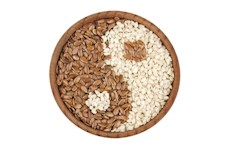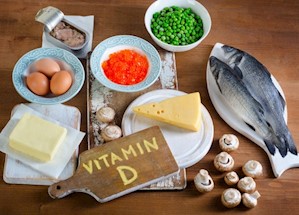 When most Americans think about nutrition for healthy bones, they think about milk and other dairy products.
When most Americans think about nutrition for healthy bones, they think about milk and other dairy products.
But, fruits and vegetables can provide many of the vitamins and minerals your body needs to build and maintain bone mass. In addition to trace minerals, fruits and vegetables contain magnesium, vitamin K and calcium. Combine these nutrients with 15 to 20 minutes of unblocked sunshine every day and you have a recipe for strong bones that will last a lifetime.
Fruits and vegetables are great digestive equalizers.
You’ve heard of taking antacid tablets for indigestion, haven’t you? They work because the calcium in the tablets neutralizes stomach acid.
A similar chemical reaction occurs in your body when the pH balance of your blood tips to the acidic side. To neutralize your blood’s pH level so your organs continue to function properly, your body extracts calcium and other minerals from your bones, which weakens your bones.
Adding more fruits and vegetables to your diet can prevent these withdrawals. Fruits and vegetables produce alkaline-like chemicals during digestion to support balanced pH levels. Eating one and a half cups of fruit and two cups of vegetables every day can help you maintain strong bones.
If you’re over 50 years old, you may want to add onions and garlic to your daily list of vegetables. It’s worth noting that one study showed women who ate onions every day had five percent more bone density than women who ate onions once a month.
Fortunately, many of the same fruits and vegetables that balance the acidity levels in your body also provide magnesium, vitamin K and calcium making it easier for you to eat enough to improve your bone health.
Magnesium helps your body absorb calcium.
Your body uses magnesium as cofactor in more than 300 biochemical reactions to function properly. It plays a major role in digestion and the absorption of calcium. To support adequate levels of magnesium in the body, women need 320 mg each day; men need 420 mg.
You can find magnesium in produce aisle in the following forms.
Vegetables
- Artichokes
- Avocados
- Beet greens
- Collard greens
- Lima beans
- Okra
- Plantains
- Potatoes
- Spinach
- Sweet potatoes
- Swiss chard
- Tomatoes (thought of as a vegetable, but technically is a fruit)
Fruits
- Bananas
- Blackberries
- Figs
- Grapefruit
- Guava
- Jackfruit
- Kiwi
- Passion Fruit
- Plantain
- Raisins
- Raspberries
- Strawberries
- Watermelon
Nuts
- Almonds
- Pumpkin Seeds
If you do not get enough magnesium from your diet, talk to your health care provider or nutritionist about taking a highly absorbable supplement such as magnesium chelate, magnesium glycinate or magnesium threonate. If you have digestive or malabsorption issues, consider using magnesium chloride oil.
Fight osteoporosis with vitamin K.
Your body uses vitamin K to generate the proteins needed for bone building. Vitamin K also impacts the bone-building process by regulating the osteoblasts and osteoclasts – the building and remodeling cells inside your bones.
To equip your body with the tools it needs to create new bone, add these vitamin K-rich foods to your grocery list.
 Vegetables
Vegetables
- Asparagus
- Avocados
- Bell peppers
- Broccoli
- Brussel sprouts
- Green beans
- Green peas
- Kale
- Parsley
- Romaine lettuce
- Spinach
- Swiss chard
- Watercress
Fruits
- Blackberries
- Blueberries
- Figs, dried, uncooked
- Grapes
- Kiwi fruit, fresh, raw
- Mulberries
- Plums, dried (prunes)
- Pomegranate juice
- Pomegranates
- Raspberries
- Rhubarb
Calcium is a major building block for overall health and bone strength.
Your body needs 1,200 milligrams of calcium to function properly every day. When your calcium levels are not high enough, your body withdraws this mineral from its storehouse – your bones. A bone-friendly diet helps your body maintain healthy calcium levels without affecting your bones.
Often, we often think of dairy products as the main source of calcium in America. Yet, surprisingly, studies from 1983, found that people who enjoy an Asian diet, which includes large amounts green vegetables, bok choy, broccoli and cabbage, suffer fewer fractures than people from countries who consume large amounts of cow’s milk.
You’ll find calcium in:
Vegetables
- Broccoli
- Chinese cabbage
- Collard greens
- Dandelion greens
- Kale
- Mustard greens
- Okra
- Turnip greens
 Fruits
Fruits
- Blackberries
- Blackcurrants
- Clementine
- Dates
- Dried Apricots
- Figs
- Guavas
- Kiwi Fruit
- Kumquats
- Lemons
- Limes
- Oranges and Tangerines
- Papaya
- Persimmons
- Pink Grapefruit
- Raspberries
- Rhubarb
- Strawberries
You can also find calcium in nuts and seeds.
- Almonds
- Flax Seeds
- Sesame Seeds
Whenever it’s possible, obtain your calcium from the foods you eat. Studies show calcium supplements may raise your risk of heart attack and stroke if they are not absorbed properly.
Combine calcium with magnesium, vitamin D and vitamin K to help your body make the most of any supplemental calcium you take. Your body cannot absorb more than 500 mg at one time. It’s best to space your intake of calcium throughout the day.
Vitamin D is essential for calcium absorption.
Vitamin D is a fat-soluble vitamin needed for bone health, immunity and mental well-being. Most Americans, especially those who live in colder climates, have vitamin D blood levels well below the 50 to 64 ng/mL considered optimal for good health.
Mushrooms are the only plant-based source of vitamin D. But, they are a source of vitamin D2 not the vitamin D3 our bodies naturally manufacture.
 Since vitamin D is a critical element for bone health, it’s worth mentioning the other dietary sources that contain the vitamin. Cod liver oil, wild-caught mackerel, salmon, cod, sardines, free-range eggs and vitamin D fortified foods such as orange juice are good sources of vitamin D.
Since vitamin D is a critical element for bone health, it’s worth mentioning the other dietary sources that contain the vitamin. Cod liver oil, wild-caught mackerel, salmon, cod, sardines, free-range eggs and vitamin D fortified foods such as orange juice are good sources of vitamin D.
The best source of vitamin D is right outside your door.
In today’s society, it’s harder for people to maintain adequate levels of vitamin D3 from the sun than it was 100 years ago,
- Our work indoors has increased while our outdoor chores have declined.
- We’ve become sun-phobic. To prevent skin cancer, we slather on sunscreen which also blocks the UV rays our skin needs to create vitamin D.
We’re not advocating giving up sunscreen, but sunlight is still the most natural way to boost the amount of vitamin D in your body.
The answer may be as simple as exposing your skin to the sun’s rays for 15 to 20 minutes each day before putting on your sunscreen. The chemical reaction in your skin supplies just the right of vitamin D for your health. You don’t have to worry about a vitamin D overdose with sunshine.
If you cannot get enough vitamin D through sun exposure or you’re the foods you eat, talk to your health care provider about taking a vitamin D3 supplement. The recommended daily allowance of vitamin D3 is 400 IU for people who are 51 to 70 years old and 600 IU after the age of 70.
Take Away:
Increase the amount and variety of the fruits and vegetables in your diet that are rich in bone-building vitamins and minerals and you can build and rebuild healthy bones that will last for your lifetime.
If you have concerns about bone health, talk to your primary care provider, a nutritionist or an orthopaedic specialist.





